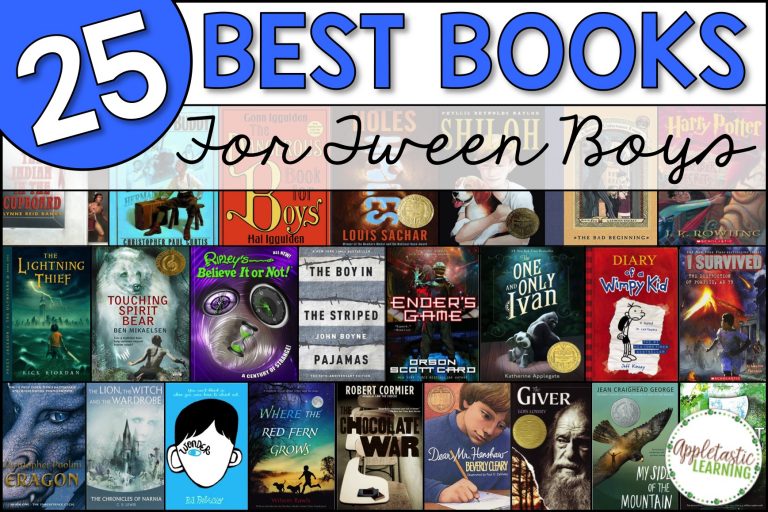
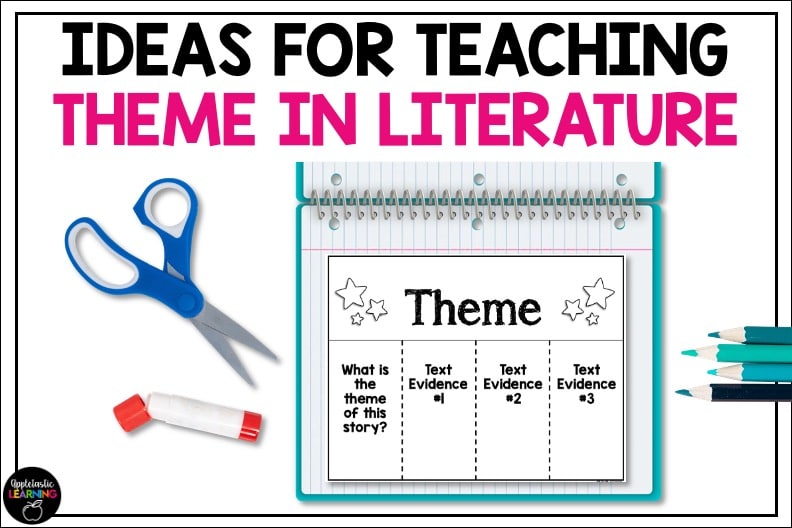
Theme worksheets that are fun and hands-on take the cake when it comes to 3rd grade, 4th grade, and 5th grade students! As a teacher, you know how important it is to engage your students with exciting and meaningful lessons. Teaching about theme is no exception.
Whether you’re exploring the theme of friendship, perseverance, or kindness, theme worksheets with reading skills practice can help students master finding the theme at the heart of any story.
In this blog post, we’ll share a variety of fun and engaging ideas for theme worksheets that will make your lessons come to life.

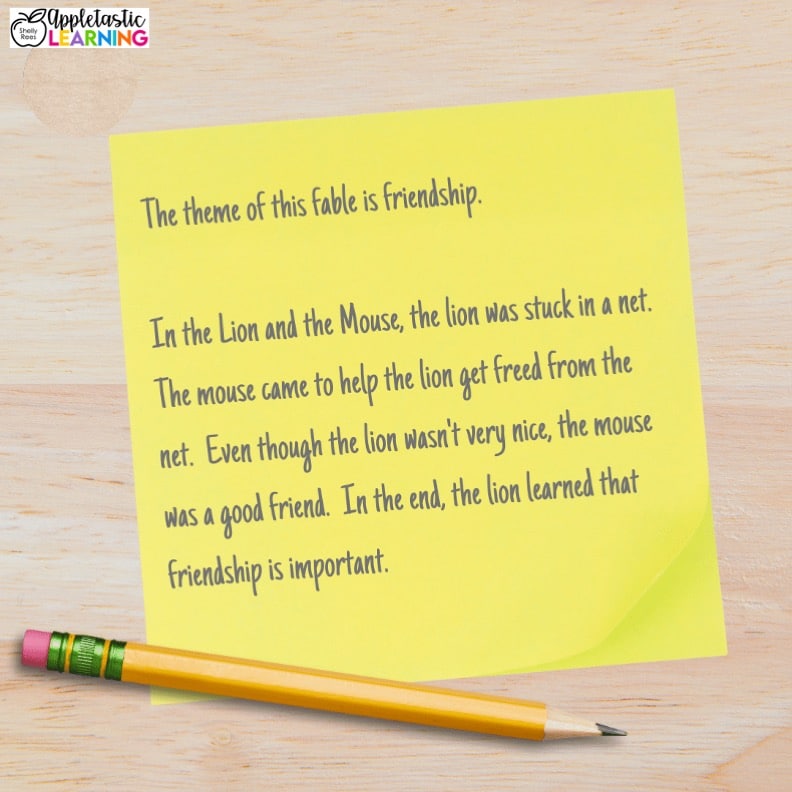
First, let’s explore what exactly theme is. Theme is the underlying message, big idea of a story, or central idea of a text. It can also be described as a life lesson that a story teaches us at a deeper level. Some common themes in literature are love, friendship, and forgiveness.
If you align your lessons to common core standards, it is important to know that identifying theme is a standard in 3rd grade, 4th grade, and 5th grade:
CCSS.ELA-LITERACY.RL.3.2
Recount stories, including fables, folktales, and myths from diverse cultures; determine the central message, lesson, or moral and explain how it is conveyed through key details in the text.
CCSS.ELA-LITERACY.RL.4.2
Determine a theme of a story, drama, or poem from details in the text; summarize the text.
CCSS.ELA-LITERACY.RL.5.2
Determine a theme of a story, drama, or poem from details in the text, including how characters in a story or drama respond to challenges or how the speaker in a poem reflects upon a topic; summarize the text.
It’s important for 4th graders to understand the theme in literature because it helps them connect more with the stories they read and think more deeply about what they mean. When students can figure out the theme, they get a better sense of the main message or lesson the author is trying to share.
This makes reading more meaningful, and students can start to think about how the theme applies to their own lives. It also helps them see how different stories might share similar ideas, which boosts their ability to compare and understand new things. Plus, when students understand the theme, they can have better conversations about the story and share their thoughts in a more thoughtful way. Overall, knowing the theme helps kids become better readers and enjoy books on a deeper level.
Many elementary school students have a hard time identifying theme. With lots of practice at the appropriate grade level, students will be ready for independent work with theme reading passages and theme worksheets in no time at all!
Through trial and error, I have found a few super effective ways to teach this challenging skill in my 5th grade classroom. In this post, I’m sharing those activities along with a few other ideas for teaching theme.
Theme should be taught in conjunction with reading comprehension and story elements such as setting, characters, main ideas, and details. Students must understand each of these individual elements together and separately.
Here are six simple ways to do this:
After we have explored the definition of theme and I’ve given some examples, it is time for a fun theme worksheet. This Moon, Mars, and Matching activity was the perfect way to practice identifying both main idea and theme.
You can choose to complete it as a whole class, small groups or independent work (if your students are ready). These short stories, theme worksheets, and answer key are part of my entire packet of theme worksheets.


Anchor charts are a great visual for students to refer to throughout a lesson. They also allow your students to be actively involved in a lesson by sharing their thoughts and ideas. Anchor charts are a great way to teach theme in literature.
So, as you can imagine I began our lesson by creating an anchor chart for theme. I displayed it at the front of the room (without the Post-It Notes; those came later). We talked about theme being the big message or lesson of the story.
And yes, theme is more than a one-word answer. We always start simple and move to more complex!
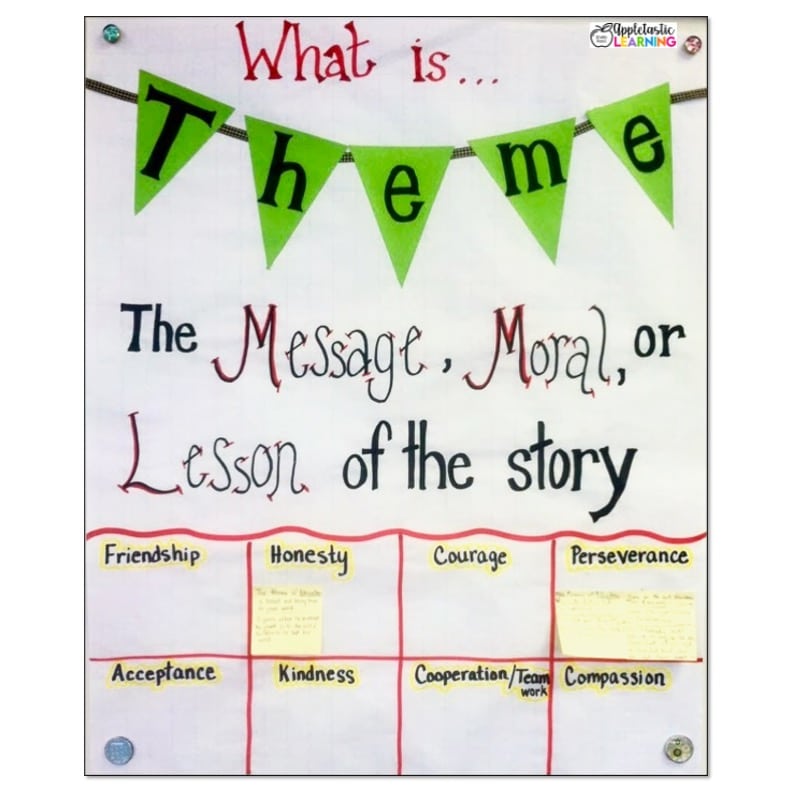
I teach my students to ask themselves this question after reading a short story:
“What did you learn from this book/story that can help you be a better person?”
That is the theme! Themes in literature have the power to change our lives for the better.
As a whole group, we talked about the example categories on the poster: Friendship, Honesty, Courage, Perseverance, Acceptance, Kindness, Cooperation, and Compassion. These are all common themes in the books and stories elementary students read. These themes all have the power to help us be better people inside.
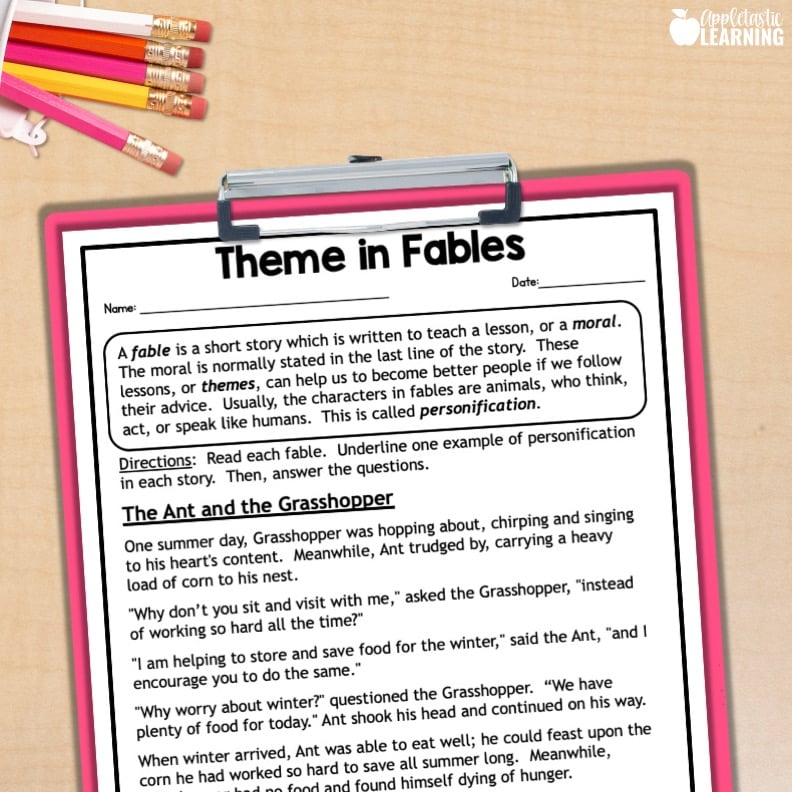
Now that the class has a basic understanding of theme and other story elements, it’s time to apply theme using short passages. Start with a short story that has a very clear theme. For example, Aesop’s fables are a great place to start! This “Theme in Fables” worksheet is included in my complete packet of theme worksheets.
I incorporate small group work any chance I can. It is a great time for students to bounce ideas off each other and share ideas. It is also a great time for informal assessment. I love to walk around the room and hear the amazing discussions taking place. This is a great tool to help me know what areas we need to revisit and improve upon.
I divide the class into small groups and have them discuss what they felt the theme of this story was. They are able to use the anchor chart we created to give them a good starting point for their discussion. They then find two pieces of text evidence to support their choice. We used this theme graphic organizer to help us identify theme. It is also a part of the packet of theme worksheets.
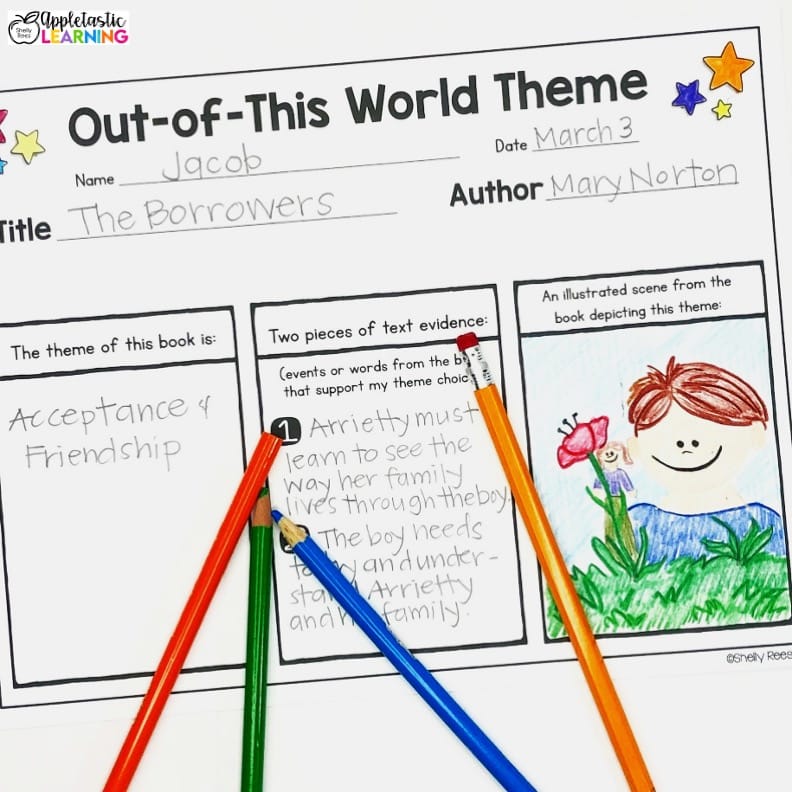
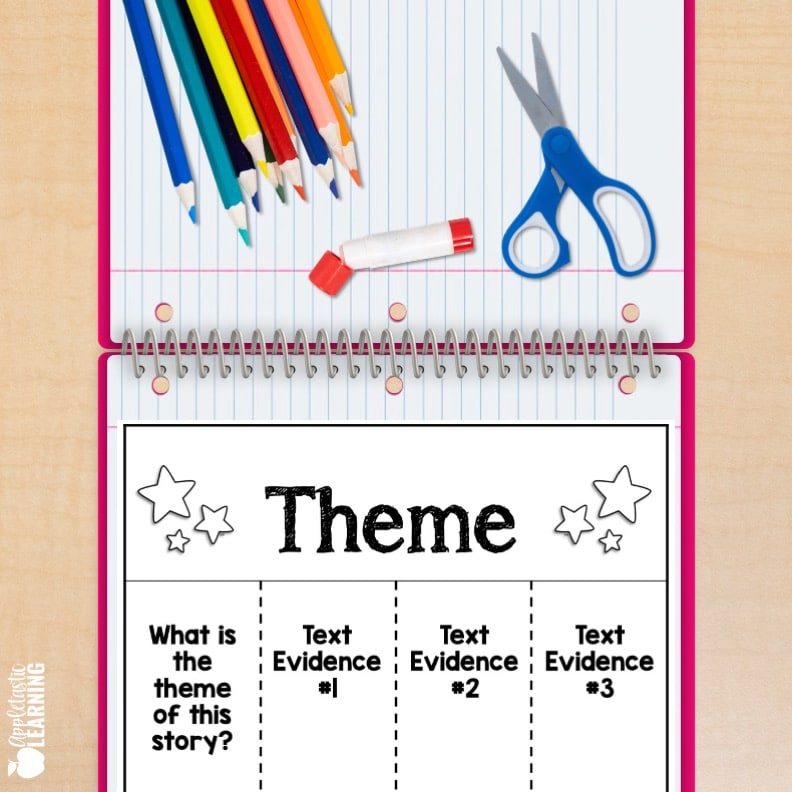
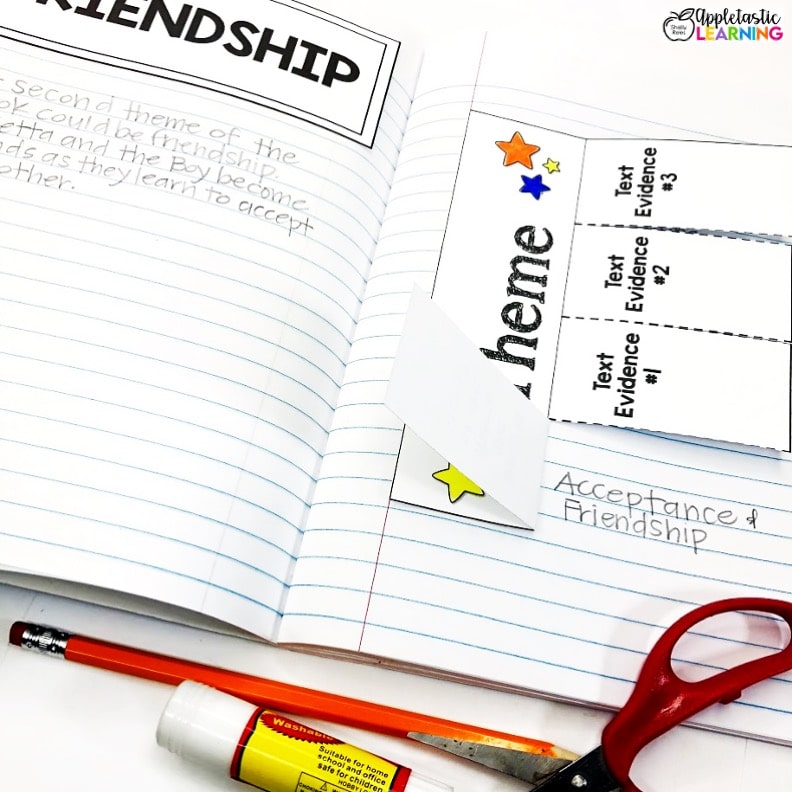
After reevaluating my teaching methods, I made one simple change. It made a HUGE difference! We started finding textual support, otherwise known as text evidence! You wouldn’t believe the pay-off I’m seeing from it. When my students are in small groups, they have to name the theme and give text-based evidence to support their answer.
We used this interactive notebook page, which is a great graphic organizer, to identify theme and text evidence. It’s a great way to get students ready for independent practice.
As the teams were talking and sharing their ideas, I heard some really great discussions – so much more in depth than in years past! Why? Students were looking in the books and finding support for their answer. It was great! All of a sudden the concept of theme really started clicking.
On a separate day, we read our story for the week from our district’s textbook. After we read it and discussed the overall theme, I gave each student a blank mini book printout (included in my Theme Worksheets Unit).
They then wrote the theme for the story and gave three pieces of text evidence to support their choice. Then the students illustrated a scene. They LOVED this activity!
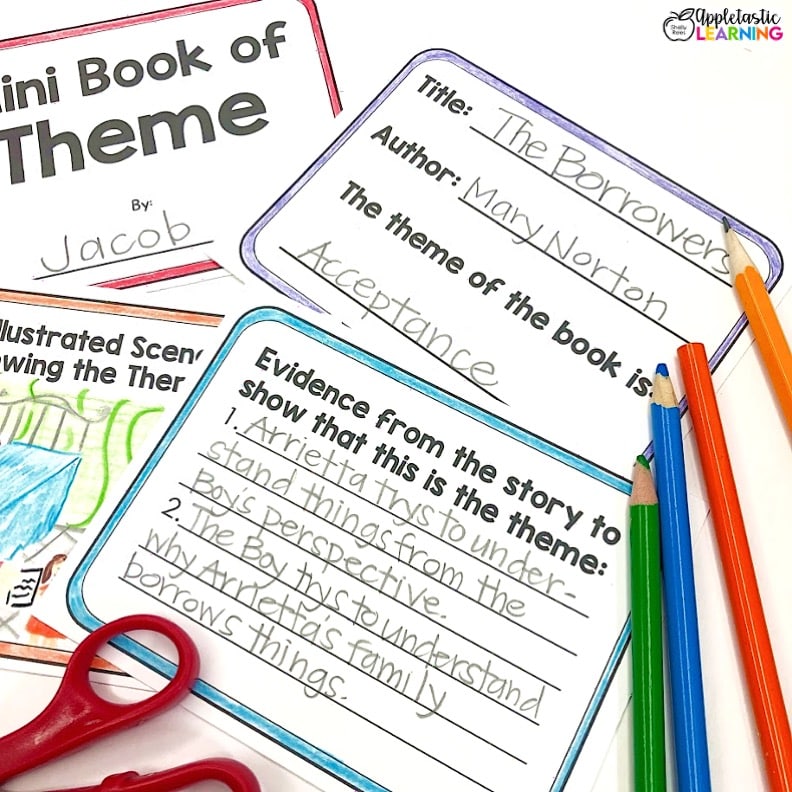
It is likely that you will want to revisit theme throughout the year. Here are ten simple ideas for your elementary students to identify theme in any reading comprehension passage.
1. Look at the Title:
The title can sometimes give a hint about the main message or theme of the story.
Worksheet idea: Provide students with short stories and have them predict the theme based on the title.
2. Pay Attention to the Main Character’s Journey:
The theme often relates to the lesson or change the main character experiences throughout the story.
Worksheet idea: Have students create a “Character Journey” chart where they outline the character’s actions, feelings, and what they learned by the end of the story.
3. Consider the Setting:
The setting (time and place) can influence the theme. For example, a story set during a war may have a theme related to peace or conflict.
Worksheet idea: Ask students to match settings with possible themes (e.g., “In a forest” → “Courage”).
4. Analyze the Conflict:
The conflict in the story (internal or external) often reflects the theme. Is it about overcoming fear, dealing with loss, or learning to be kind?
Worksheet idea: Provide examples of conflicts (e.g., “character vs. nature”) and have students identify what theme the conflict might suggest.
5. Look for Repeated Ideas or Symbols:
Symbols or ideas that are repeated throughout the story can reveal the theme. For example, the symbol of a bird might represent freedom.
Worksheet idea: Give students a list of symbols and themes to match or identify symbols in a text.
6. Identify Key Lessons or Morals:
What lesson does the story teach? Many stories have a moral, such as “honesty is important” or “perseverance leads to success.”
Worksheet idea: Ask students to summarize the story’s message or lesson in a sentence.
7. Examine the Ending:
The ending often reveals the theme, especially if it shows a resolution to the main conflict or a moral lesson learned.
Worksheet idea: Have students write a “What happened?” summary at the end of a story and identify the theme based on the resolution.
8. Look at the Characters’ Relationships:
How characters interact with each other can reflect a theme, such as friendship, loyalty, or kindness.
Worksheet idea: Have students list the main characters and describe their relationships. Then, ask them to infer the possible theme.
9. Pay Attention to the Author’s Word Choices:
Sometimes, an author’s language can hint at the theme. For example, words like “brave,” “strong,” or “hopeful” can suggest themes of courage and hope.
Worksheet idea: Have students underline words or phrases that reveal the theme in a short passage.
10. Reflect on the Story’s Overall Mood or Tone:
The mood or tone of the story (e.g., happy, sad, suspenseful) can give clues about the theme. A sad tone might indicate a theme about loss or dealing with hardship.
Worksheet idea: Ask students to describe the mood of the story and suggest how that mood relates to the theme.
Be careful to not overwhelm your students with an onslaught of boring worksheets. Keep worksheet time light and meaningful. There are several fun ways to have students complete any reading worksheets:
After the team meetings, the spokesperson for each group shared the theme of this story with the class and gave text evidence to support their answer. Using their answers (they all identified honesty as being the theme), I modeled how to fill out a sticky note for the anchor poster.
At the close of the lesson, I challenged students to fill out their own sticky notes for the chart in the coming weeks. After taking and passing an AR quiz on any novel, they are welcome to add a theme note to the chart. Several notes have been added so far! I love reading what my students have written. I love even more that they are now supporting their answers with examples from the text!
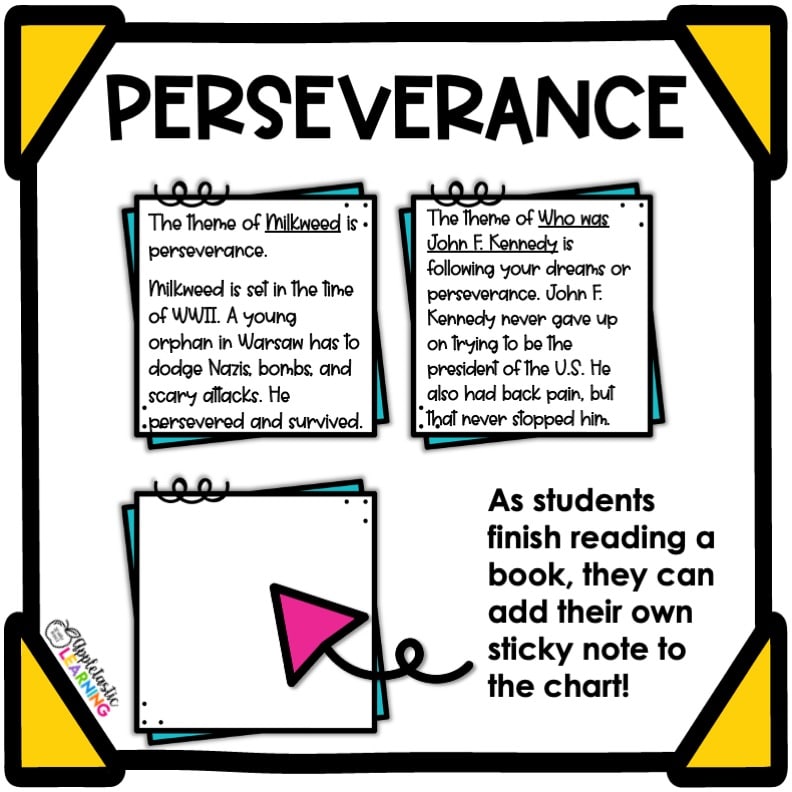
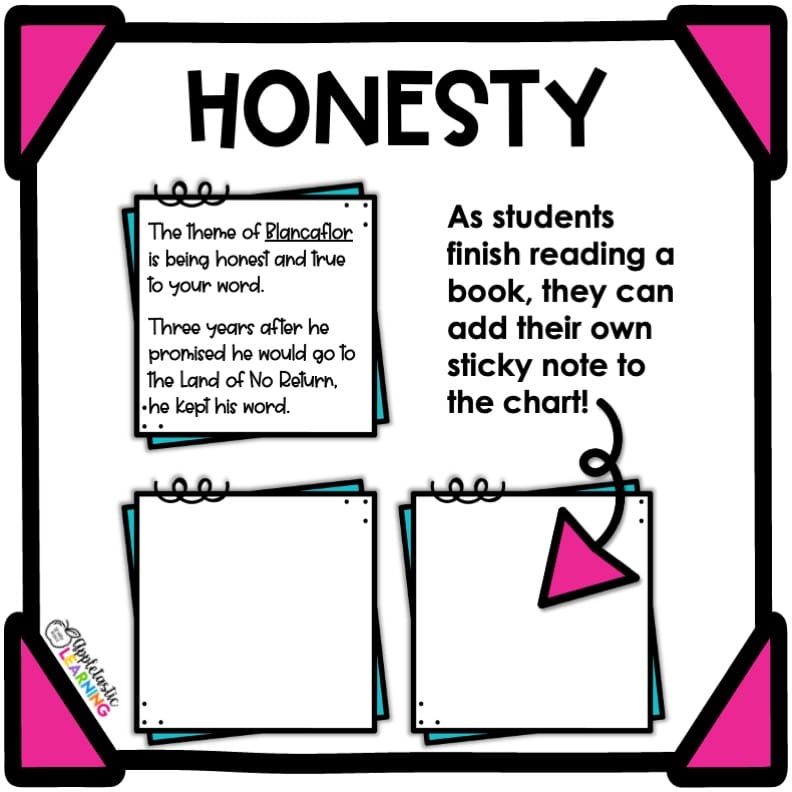

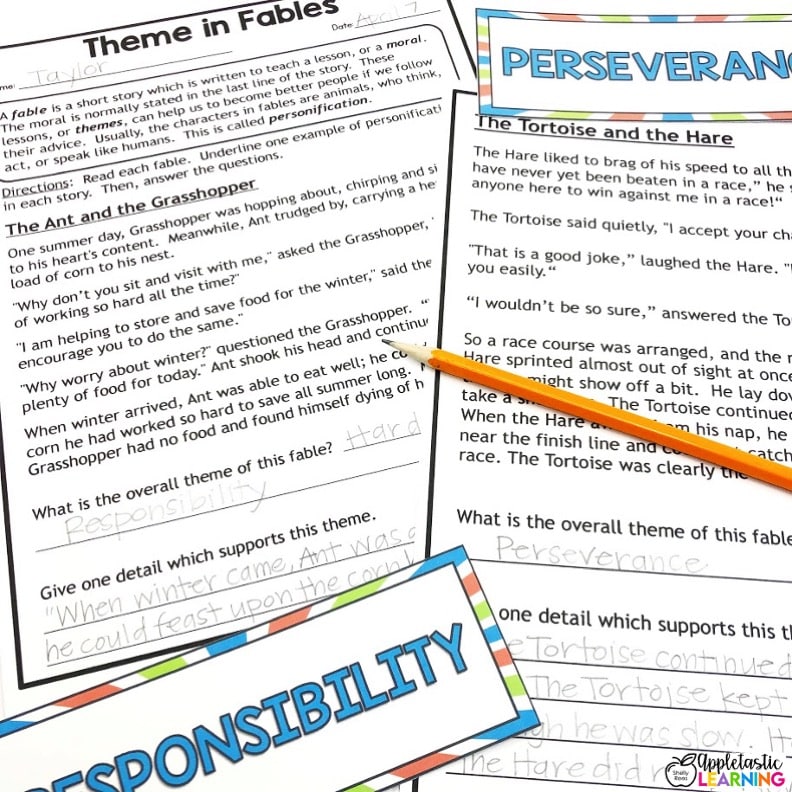
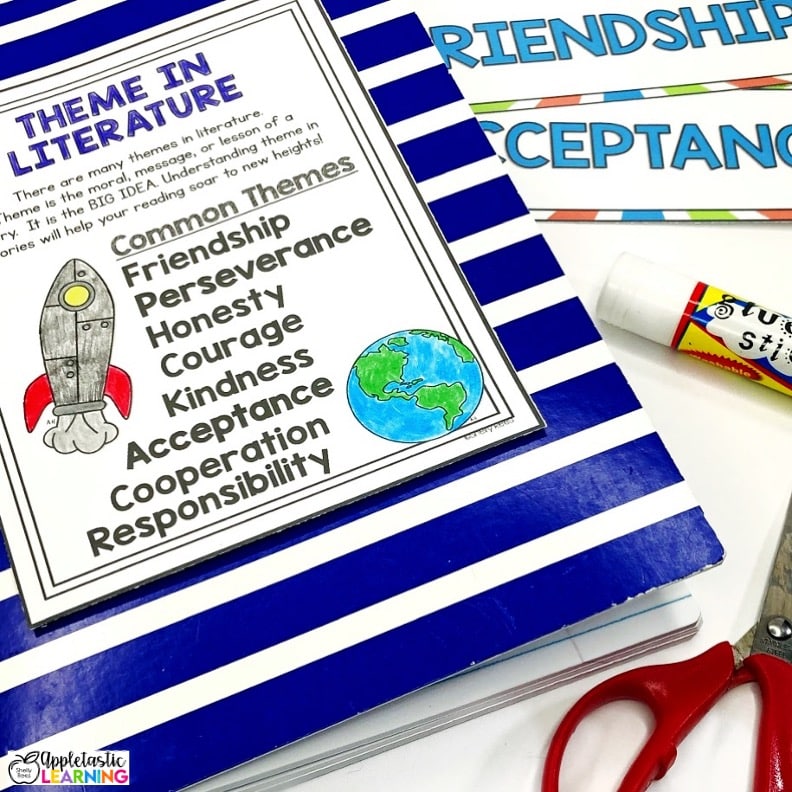
As you can see, teaching theme is a work in progress. We are not totally there yet, so I am extending our in-depth look at theme for a few more weeks. We will be working on deepening our understanding of theme with these the entire Theme Unit that I created. It is perfect for increasing critical thinking, improving reading comprehension, and test prep needs!
This Theme in Literature Unit includes:
All the theme worksheets, activities, and printables in this packet are very easy to use! Simply print and use in your classrooms. It is suggested that the colored poster and labels be laminated for longer use.
This packet is perfect for:
I hope you find these fun ideas for teaching theme to be helpful!
On another note, here are some other blog posts on teaching topics that I LOVE. Maybe you will, too!


Hi, I’m Shelly! Thank you for being here. I love helping third, fourth, and fifth grade teachers with fun and engaging activities that require no to little prep! Let me help you by taking some of the stress and work off your plate.

©2022 Shelly Rees. All Rights Reserved.